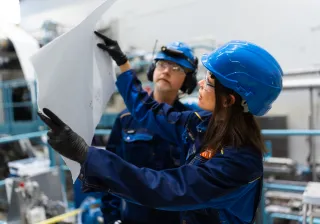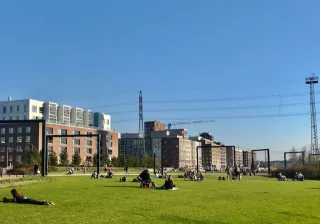Boliden’s new sulphuric acid plant didn’t pass commissioning because of high emission levels. VTT’s measurements supported Boliden and their technology partner in locating and fixing the problem in the production process. Boliden now has a cutting-edge plant that enables sustainable sulphuric acid production in the long term.
Key facts
Pioneering, objective emission measurements in challenging conditions
Cutting-edge sulphuric acid plant passes commissioning
Significant SO2 emission reductions
Founded in 1924, Boliden is a high-tech metal company operating mines and smelters that guarantee a supply of base and precious metals for various industries. Today, around 6,000 people work for the company in Sweden, Finland, Norway and Ireland. Boliden is a public limited company with shares and securities listed on the NASDAQ Stockholm.
Sustainable sulphuric acid in high industrial demand
Traditionally, sulphuric acid has been a by-product of oil processing or recovered from metallurgical plant off-gases.
As a long-term investment in sustainable production, Boliden contracted their technology partner company to design and deliver key technology equipment to the new sulphuric acid plant in Harjavalta, Finland. The goals were to increase production capacity and minimise the environmental impact of production processes and other installations with Best Available Technology (BAT). Boliden wanted the plant to cleanly pass environmental regulations for the next few decades.
During commissioning, however, it became evident that the sulphur dioxide (SO2) emissions were higher than the set emission limits. It was unclear whether the issue was with the sulphur dioxide analyser or the production process itself. As the reason was not identified, only a partial approval of the technology delivery was granted.
To get to the bottom of the high emission levels, Boliden and their partner decided to hire an independent third party to study the production equipment and process. As the analysis required performing tests that had never been successfully conducted before, both parties opted for VTT.
“This project was not suited for an average consultant. It required vast experience in emissions, conducting field tests in challenging conditions and the ability to scientifically prove the findings,” says Jukka Tähkä, Boliden’s Manager of Sulphuric Acid Plants.
Finding the right test methods and equipment to pinpoint the problem
When VTT got involved in the analysis of emission levels at the Harjavalta plant, there were three objectives for the measurements:
- Validating that the emission levels truly were higher than what was agreed on.
- Pinpointing the parts of the process that needed adjustments.
- Verifying that the process adjustments fixed the problems.
Validating that the plant’s own measuring system worked was the easy part, since it could be done by concentrating solely on the end of the process.
It was much harder to try to locate what caused the high emission levels. Measuring the various parts of the production process required VTT to work in challenging conditions, including outside in the rain and in high places. Sulphuric acid plants also have a risk of gas leaks. This is why safety had to always come first.
Another challenge with locating the emission source was trying to measure the level of sulphur dioxide among huge amounts of sulphur trioxide (SO3). As sulphur trioxide reacts easily with water, VTT’s scientist had to pay special attention to ensuring that there was no risk of the sulphur trioxide and moisture forming sulphuric acid in the sampling lines.
Based on VTT’s measurements, the problem was located to a section at the end of the production process. After this, Boliden and its technology partner were able to develop new solutions to optimise the production process. Finally, VTT conducted new tests to validate that the plant had reached the targeted emission levels.
“At VTT, we combine the right experts with the right methods and test equipment. This project was so challenging that every aspect had to work in tandem for us to succeed,” says Tuula Kajolinna, the VTT Research Scientist responsible for conducting the field tests.
Cutting-edge plant reduces emissions in the long term
After the plant reached the targeted emission levels, it could be successfully commissioned.
“VTT helped us to locate the problem in the production process effectively with spot-on methods and testing. VTT’s experts were top scientists who were also ready to get their hands dirty. After VTT’s findings, it was easy to focus on the specific problems in our process,” Tähkä says.
The plant’s sulphur dioxide emissions are over fifty percent smaller than what is required by the EU BREF regulation. This ensures the long-term future of Boliden’s sulphuric acid operations and metallurgical business in Harjavalta.
For VTT, the project was a unique opportunity to measure and optimise the performance of a new sulphuric acid plant. VTT showcased how combining challenging hands-on measurements, the optimisation of production processes and academic studies are the recipe for more sustainable industrial operations.
Transparency and trust create a solid foundation for future collaboration
The project between Boliden, their technology partner and VTT was built on mutual respect, trust and transparency.
“VTT’s approach is holistic. We bring together the best minds, technologies, academic research and legislation knowledge. In this project, we could prepare well and were ready for the challenge when the measurements began,” says Tuula Pellikka, Principal Scientist at VTT.
“The teamwork between VTT and Boliden was seamless. We wanted an independent third-party organisation for this case, and VTT was the right partner for that,” Tähkä concludes.







